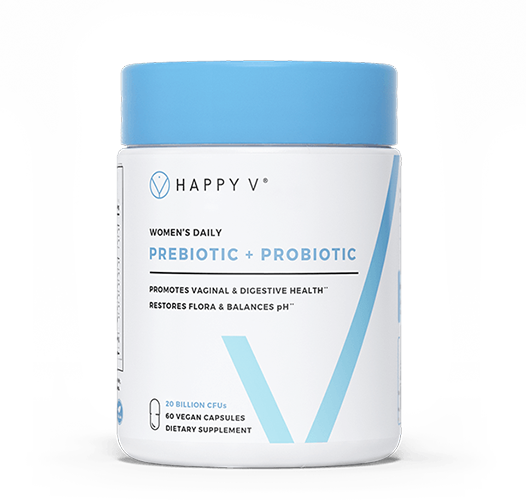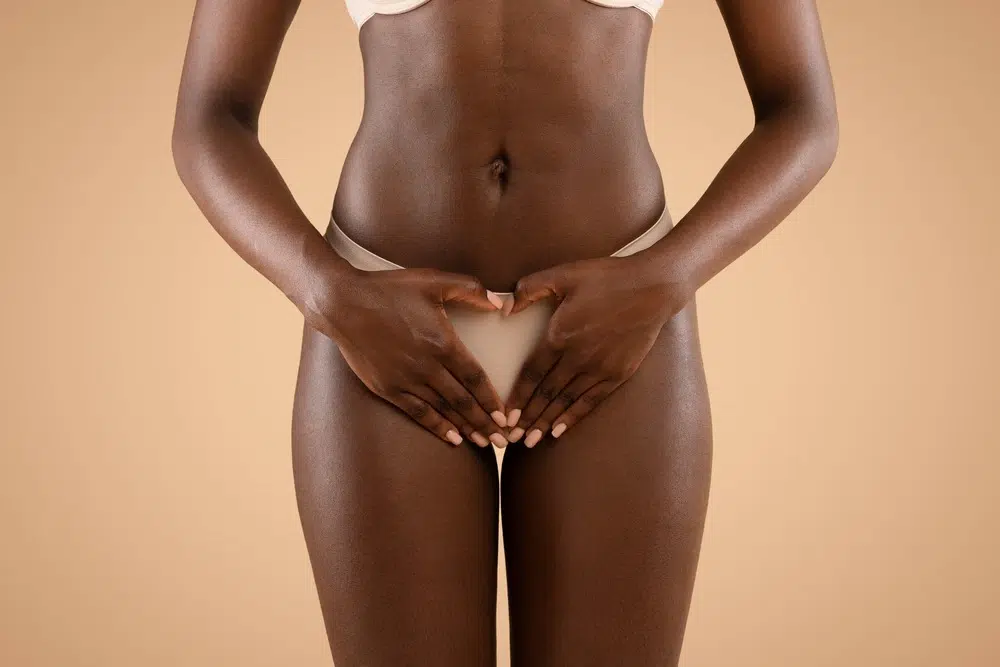- The most common symptoms of a yeast infection include cottage cheese-like vaginal discharge and itchiness.
- Yeast infections can sometimes cause sores. These sores often look like red, raw patches of skin that can resemble paper cuts.
- The sores associated with yeast infections are not solid bumps or blisters. These kinds of sores may be a sign of an STD like genital herpes and should be investigated by a doctor.
- If you have yeast infection sores, focus on keeping your genital area clean and dry and taking your antifungals exactly as your doctor has prescribed.
- Prevent yeast infections from coming back by practicing good vaginal hygiene and taking a daily vaginal probiotic.

Introduction
Yeast infections often come with a few tell-tale symptoms, most of which are pretty uncomfortable. These include thick, cottage cheese-like discharge, vaginal itching, and stinging or burning during urination. But what about sores? Do yeast infections ever involve painful, red, almost blister-like sores in the genital area? Or are they a sign of something else?
If you are experiencing unexplained sores, you probably feel a little freaked out. Hopefully, after reading this today, you’ll have the answers to stop worrying and start taking action.
Understanding Yeast Infections

Before we can understand how yeast infections might cause sores, we have to understand what a yeast infection is and how it behaves in the body. Essentially, yeast infections are caused by an overgrowth of the fungus Candida. While we will be talking about vaginal yeast infections, yeast infections can also occur in the mouth, throat, and folds of the skin.
Symptoms of a vaginal yeast infection include:
- Vaginal discharge that is thick, white, and odorless1
- Itchiness
- Redness
- Pain when urinating
But self-diagnosing a yeast infection can be difficult, as symptoms can often overlap with other common infections like BV or UTIs, though in the case of BV, the discharge is often thin, gray-ish, and accompanied by a strong or fishy odor.2
Because there is so much overlap in symptoms, if you ever suspect a vaginal infection, you should always see your doctor to confirm a diagnosis.
An In-Depth Look at Yeast Infection Sores

Along with unusual vaginal discharge and itching, yeast infections can also cause sores to the vulva, anus, and skin folds of the genital area. But it’s important to know what these look like (and don’t look like) so you don’t confuse them for the sores associated with genital herpes.
Yeast infection sores are often described as raw or cracked patches of skin around the groin area. Some people describe them as looking and feeling almost like paper cuts. Generally, these sores are caused by extreme inflammation brought on by Candida overgrowth and are flat to the touch and not a bump or blister. Generally, bumps and blisters are a sign of something else. As for what that “something else” could be, we will dive into that in just a bit!
Yeast Infection Sores vs Bumps

It’s important to understand that when we are talking about yeast infection sores, we are not talking about bumps. Though people think the words “sores” and “bumps” are interchangeable, they refer to different things. Sores are open, red, raw areas of skin. This is different from bumps, which are raised areas of the skin that often feel firm or solid to the touch. And while sores are typically quite painful, bumps are less painful or not painful at all.
What bumps and sores have in common, though, is that they should never be ignored. While sores are often associated with severe yeast infections, there could be other reasons, too, that only a doctor can identify for sure.
Symptoms of Severe Yeast Infections

While sores can be a symptom of a yeast infection, they are not an overly common symptom, and if they are widespread, they are generally a sign of a severe yeast infection.
Other signs of severe infection include:
- Extensive redness
- Extreme swelling
- Fever
While any sign of a yeast infection should warrant a call to your doctor, signs of severe infection require immediate attention. While mild yeast infections can often be treated using over-the-counter antifungals, severe outbreaks may require more aggressive, prescription treatment.3
Yeast Infection Sores vs Herpes

While symptoms of a mild yeast infection may be confused with symptoms of another infection like a UTI, the symptoms of a severe yeast infection (and yeast infection sores in particular) can be confused with the sores associated with genital herpes, though there are some key differences in appearance and other associated symptoms.
Though we will get into these differences next, it’s important to know that you should never attempt to diagnose yourself. You should always seek a doctor’s opinion. Genital herpes is an STD, which means that misdiagnosis can have serious health consequences for you or a sexual partner.
Herpes: An Overview and Its Symptoms

Like we said, genital herpes is an STD or sexually transmitted disease. This means that it is a disease that is passed from person to person exclusively through sexual contact, which can include vaginal sex, oral sex, or anal sex.
When we talk about contracting herpes, we are talking about the transmission of one of two viruses:
Herpes simplex virus type 1 (HSV-1) or herpes simplex virus type 2 (HSV-2)4.
Genital sores are the tell-tale sign of genital herpes, and these sores differ from yeast infection sores. The sores associated with yeast infections can vary in size, while the sores associated with genital herpes tend to appear more uniform and resemble blisters. When these blisters pop, they can expose raw, red skin underneath, which can sometimes be confused for yeast infection sores. Again, this is why a doctor’s evaluation is so important.
While yeast infection sores are often accompanied by odorless, cottage cheese-like discharge, genital herpes sores are associated with symptoms like:
- Smelly genital discharge
- Bleeding between periods (if you have a menstrual cycle)
- Swelling of the lymph nodes
- Flu-like symptoms
While genital herpes, like all STDs, cannot be cured, these painful outbreaks can be managed with the help of your doctor.
When to Consult a Medical Professional

No matter if it’s mild or severe, If you ever suspect you have a vaginal infection, STI, or STD, you should make an appointment with your doctor.
If your doctor diagnoses you with a yeast infection, you must continue to monitor your symptoms and make a follow-up visit if you feel like symptoms are persistent, despite treatment, or causing you severe discomfort.
Managing Yeast Infections Sores
The best way to manage yeast infection sores is to treat the fungus causing the infection, which is generally done through over-the-counter or prescription antifungal medication. Your doctor will advise you which option is best for you during your appointment.
Other than that, make it a point to keep the genital area clean and dry while your sores are healing. You can do this by wearing breathable cotton underwear and loose bottoms.
Prevention and Long-Term Health Maintenance
Wearing cotton underwear isn’t just a good idea when you have yeast infection sores. It is a good idea in general since it allows the area to breathe, preventing moisture build-up that enables yeast growth5.
Other good hygiene measures for preventing yeast infections include reducing sugar intake since sugar also fuels yeast growth, and changing your underwear and pants promptly after working out.
If you have recently had a severe yeast infection or have had multiple infections, also consider taking a daily probiotic to help restore your vaginal microbiome and give it the good bacteria it needs to fight off the bad. Just look for one like Happy V’s Prebiotic + Probiotic that is doctor-formulated for vaginal health and contains clinically proven strains of Lactobacillus.
Frequently Asked Questions
- How do I know if my yeast infection sores are mild or severe?
Generally, any kind of sore is considered a sign of a more severe yeast infection and should be seen by a healthcare provider ASAP.
- How long do yeast infections last?
Once you begin treatment, mild infections often resolve within a few days, though more severe or complicated infections can take longer.
- What lifestyle changes can I make to stop recurrent infections?
Candida likes damp, moist areas and sugar, so consider switching to cotton underwear and limiting your sugar intake to prevent their growth. Using condoms during sex, not douching, and avoiding scented soaps and body washes can also help prevent future yeast infections5.
- Yeast Infection: An overgrowth of the fungus Candida in the body, commonly occurring in the vaginal area.
- Candida: A type of fungus that can cause infections in various parts of the body, including the vagina, mouth, throat, and skin folds.
- Vaginal Discharge: Fluid that comes from the vagina, which can vary in color, consistency, and odor.
- BV (Bacterial Vaginosis): A vaginal condition caused by an imbalance of bacteria, often leading to thin, gray-ish discharge with a strong or fishy odor.
- UTI (Urinary Tract Infection): An infection in any part of the urinary system, often causing pain or burning during urination.
- Herpes Simplex Virus (HSV): A virus causing herpes, which can appear as sores or blisters on the genital area (HSV-2) or mouth (HSV-1).
- Lymph Nodes: Small glands that filter lymph, part of the immune system, and can swell during infections.
- Flu-like Symptoms: Symptoms resembling the flu, such as fever, body aches, and fatigue, often associated with viral infections like herpes.
- Antifungal Medication: Drugs used to treat fungal infections, available over-the-counter or by prescription.
- Probiotic: Live bacteria and yeasts beneficial for health, particularly for the digestive and vaginal microbiome.
- Meena V, Bansal CL. Study to Evaluate Targeted Management and Syndromic Management in Women Presenting with Abnormal Vaginal Discharge. J Obstet Gynaecol India. 2016;66(Suppl 1):534-540. doi:10.1007/s13224-016-0879-x
- Think You Have a Vaginal Infection? Here’s What You Need to Know. The American College of Obstetricians and Gynecologists. https://www.acog.org/womens-health/experts-and-stories/the-latest/think-you-have-a-vaginal-infection-heres-what-you-need-to-know . Accessed November 24, 2023.
- Yeast infection: Signs & symptoms. WebMD. Accessed April 30, 2024. https://www.webmd.com/women/common-symptoms-of-a-yeast-infection
- Std Facts – Genital herpes. Centers for Disease Control and Prevention. January 3, 2022. Accessed April 30, 2024. https://www.cdc.gov/std/herpes/stdfact-herpes.htm
- Menstrual Hygiene. Centers for Disease Control and Prevention. https://www.cdc.gov/hygiene/personal-hygiene/menstrual.html . Accessed November 24, 2023
- A-
- A+






